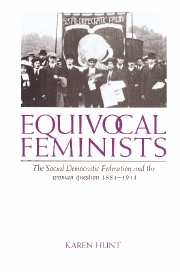Book contents
- Frontmatter
- Contents
- Acknowledgements
- Introduction
- Part 1 The woman question: the theory
- Part 2 The SDF and the woman question: the theory and practice of the party on aspects of the woman question
- Part 3 Women and the SDF: the practical implications of the SDF's understanding of the woman question
- 7 The SDF's attitude to women as potential socialists
- 8 Women SDFers and their role in the party
- 9 The organisation of women within the SDF
- Conclusion
- Appendices
- Bibliography
- Index
7 - The SDF's attitude to women as potential socialists
Published online by Cambridge University Press: 14 January 2010
- Frontmatter
- Contents
- Acknowledgements
- Introduction
- Part 1 The woman question: the theory
- Part 2 The SDF and the woman question: the theory and practice of the party on aspects of the woman question
- Part 3 Women and the SDF: the practical implications of the SDF's understanding of the woman question
- 7 The SDF's attitude to women as potential socialists
- 8 Women SDFers and their role in the party
- 9 The organisation of women within the SDF
- Conclusion
- Appendices
- Bibliography
- Index
Summary
The SDF's understanding of the woman question made a virtue out of the political vacuum it created around women. In particular, the notion that issues associated with the woman question were matters of conscience allowed all sorts of assumptions about women to gain credibility within the SDF. Views which stereotyped and denigrated women appeared alongside pleas for toleration and positive images of women's capabilities. To say the least, this gave a contradictory and confusing picture of the party to existing and potential women members.
Women as a problem for socialism
Within the SDF, just as outside it, women as a sex were generalised about in a way which was never done for men. The male sex was not dealt with as an undifferentiated mass; it was distinguished through a variety of categories such as class, trade and political conviction. The same rarely applied to women. As a sex, they were seen by SDFers as a reactionary force in society. There was disagreement as to whether women were naturally or socially conditioned to be conservative, but there was a general fear that they constituted a threat to socialism. This was sometimes voiced in terms of women's presumed reactionary influence in municipal elections, but it was more commonly expressed as a general belief in women's ‘indifference, ignorance and apathy’.
The assumed conservatism of women took two forms: one based on apathy with conservatism as its result and another rather more active conservatism where women's influence prohibited or limited the participation of others in socialist politics.
- Type
- Chapter
- Information
- Equivocal FeministsThe Social Democratic Federation and the Woman Question 1884–1911, pp. 187 - 203Publisher: Cambridge University PressPrint publication year: 1996

